Digital Poster
AD: Diagnosis, Progression & Staging
ISMRM & ISMRT Annual Meeting & Exhibition • 10-15 May 2025 • Honolulu, Hawai'i

 |
Computer Number: 129
2993. Multi-parameters
diffusion MRI reveals microstructural changes with the
progression of Alzheimer’s disease
Y. Ma, H. Gao, T. Jin, R. Qian, B. Gu, D. Wu, Z. Zhao
Zhejiang University, Hangzhou, China
Impact: Our findings demonstrate that multi-parameters
diffusion MRI identify stage-specific biomarkers by
revealing brain microstructural changes, and this may
enhance accuracy of early diagnosis of Alzheimer’s disease
and further improve patients’ outcomes.
|
|
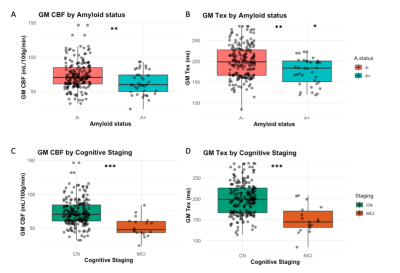 |
Computer Number: 130
2994. Blood-brain
barrier water permeability in relation to Alzheimer’s Disease
and age-related vascular damage
B. Padrela, S. Tecelão, M. Tranfa, O. Geier, M. Sneve, D.
Vallez Garcia, A. Mahroo, L. Pålhaugen, B-E Kirsebom, K.
Eickel, D. Thomas, A. Bjørnerud, A. Fjell, K. Walhovd, F.
Barkhof, P. Selnes, M. Günther, J. Petr, T. Fladby, H.
Mutsaerts
Amsterdam UMC, Amsterdam, Netherlands
Impact: Our results suggest that multi-TE ASL MRI BBB
water permeability can be used as an early imaging biomarker
of AD pathophysiology.
|
|
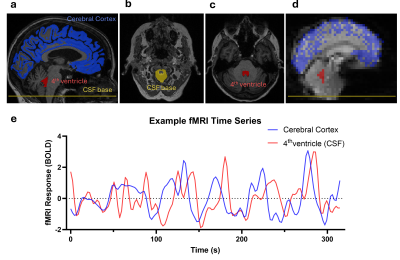 |
Computer Number: 131
2995. Altered
cerebrospinal fluid dynamics in Alzheimer's disease as measured
by resting-state fMRI
L. Tang, Q. Gu, T. Wu, H. Mao
Emory University, Atlanta, United States
Impact: Investigating rsFMRI data revealed distinct
patterns in CSF flow dynamics among AD and MCI subjects
compared to normal controls, providing a foundation to
improve the characterizations of AD or other degenerative
diseases.
|
|
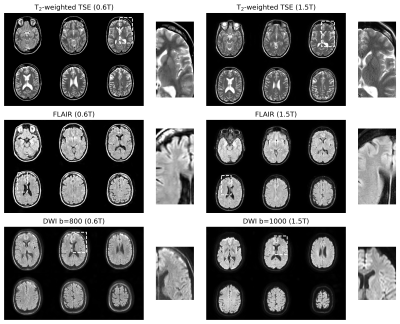 |
Computer Number: 132
2996. An
11-minute ARIA brain protocol for 0.6T
M. Nagtegaal, Y. Dong, N. Jabarimani, E. Ercan, A. Webb, P.
Börnert, M. van Buchem, M. van Osch
Leiden University Medical Center, Leiden, Netherlands
Impact: This study shows that 0.6T MRI can provide neuro
MRI scans in line with ARIA guidelines of diagnostic quality
in a scan time comparable to standardized 1.5T ARIA
monitoring protocols.
|
|
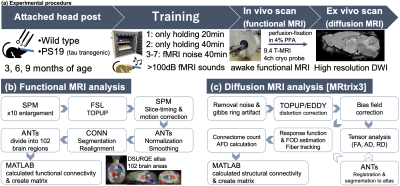 |
Computer Number: 133
2997. Pathological
changes in brain networks in P301S tau transgenic mouse model
H. Oshiro, K. Kawamata, J. Hata, R. Koike, T. Marusaki, A.
Ishida, C. Kawai, C. Tokisugi, Y. Soeda, A. Takashima, H.
Okano
Tokyo Metropolitan University, Tokyo, Japan
Impact: The establishment of tauopathy imaging using MRI
could lead to the early and non-invasive detection of
tau-related diseases, such as Alzheimer's disease.
|
|
 |
Computer Number: 134
2998. Effect
of protein concentration on MRI quantitative values: Comparison
between 7T MRI and 11.7T MRI.
K. Tateno, Y. Komaki, K. Oshio, N. Nitta, J. Hata
Tokyo Metropolitan University, Tokyo, Japan
Impact: The effect of protein concentration on each
quantitative MRI value was determined. The results showed
that T2 most acutely captured changes in albumin
concentration. A more detailed T2 analysis revealed the
possibility of estimating solute concentration in the brain.
|
|
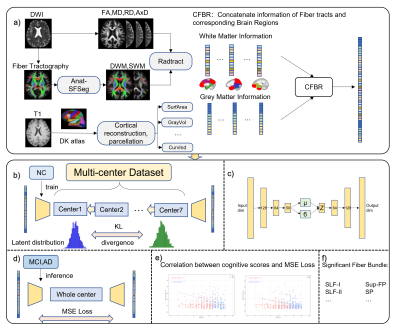 |
Computer Number: 135
2999. A
New imaging Biomarker of Gray-White Matter Covariance in
Alzheimer's Disease Using a Variational Autoencoder-based
Framework
Q. Zhang, D. Zhang, K. Zhao, Y. Liu, F. Zong
School of Artificial Intelligence, Beijing University of Post and Telecommunication, Beijing, China
Impact: This study enhances our understanding of the
interdependence between the structure of gray matter brain
areas and white matter fiber tracts in Alzheimer's Disease,
and a new cognitive-related biomarker was proposed.
|
|
 |
Computer Number: 136
3000. Additional
evidence that cortical thickness relates to later dementia
symptoms in non-demented adults with Down syndrome
K. Koenig, P. Bhattacharyya
The Cleveland Clinic, Cleveland, United States
Impact: This work shows that early-occuring
neuroanatomical differences in Down syndrome (DS) are
related to dementia symptoms, suggesting the mechanisms
behind these differences are worth considering in the drive
to develop biomarkers of Alzheimer’s disease in DS.
|
|
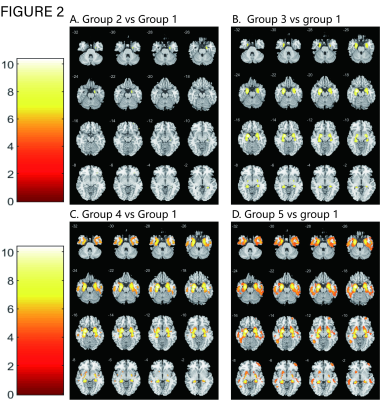 |
Computer Number: 137
3001. The
evaluation of patterns in gray matter damage during the
development of Alzheimer's disease by using VBM analysis
S. Lin, W. Wang, J. Lian
First Affiliated Hospital of Harbin Medical University, harbin, China
Impact: VBM analysis can reveal the morphological
changes of gray matter across the AD continuum, thereby
revealing the temporal and spatial progression of AD
pathological changes.
|
|
 |
Computer Number: 138
3002. Multimodal
Fusion for Staging Classification in Alzheimer's Disease Using
Extended parallel multilink joint ICA
C. Lv, Y. Guo, F. Chen
Hainan University, Haikou, China
Impact: The observed differences of loading parameters
among AD, MCI, SCD, and NC suggested that the combination of
multimodal data may provide useful biomarkers for improving
the accuracy AD diagnosis.
|
|
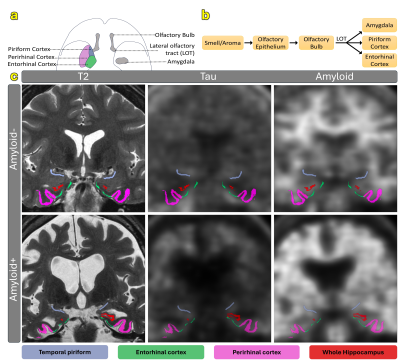 |
Computer Number: 139
3003. Quantification
of Amyloid in the Piriform Cortex in Alzheimer’s and Parkinson’s
Disease using PET-MR
H. Moein Taghavi, M. Karimpoor, E. van Staalduinen, C.
Young, M. Georgiadis, M. Carlson, A. Romero, A. Trelle, H.
Vossler, M. Yutsis, J. Rosenberg, G. Davidzon, G. Zaharchuk,
K. Poston, A. Wagner, V. Henderson, E. Mormino, M. Zeineh
Stanford University School of Medicine, Stanford, United States
Impact: We show amyloid uptake in the piriform cortex as
well as other medial temporal regions, including the
entorhinal-perirhinal cortices. These results further enrich
the scientific understanding of the role of the piriform
cortex in the progression of early AD.
|
|
 |
Computer Number: 140
3004. MRI-Based
Hippocampal Radiomics for Early Diagnosis and Staging of
Alzheimer's Disease
T. T. Yin, L. Han, Z. Z. Jia
Affiliated Hospital of Nantong University, Nantong, China
Impact: The potential of T1WI-based hippocampal
radiomics features for diagnosing AD is emphasized in this
study. Our findings provide enhanced insights into AD
diagnosis, progression monitoring, and potential management
guidelines.
|
|
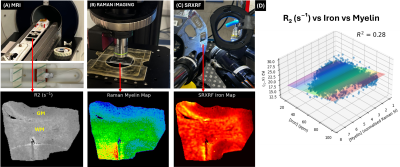 |
Computer Number: 141
3005. Using
Multimodal Imaging to Investigate the Relationship Between Iron,
Myelin, and MRI Relaxation
C. Taylor, E. Kim, H. Parkes, C. Troakes, P. Wah-So
King's College London, London, United Kingdom
Impact: This work applies SRXRF and Raman imaging to
estimate the contributions of iron and myelin to MRI
relaxation. The results can be utilised to increase the
specificity of MRI relaxation mapping measurements to iron.
|
|
 |
Computer Number: 142
3006. Increased
Peripheral Blood Plasma Amyloid and Tau Concentrations
Associated with MR Elastography Measures of Brain Stiffness
M. Kramer, N. Pyontek, N. Rizzi, K. Decker, M. Cohen, A.
Lanzi, C. Martens, C. Johnson
University of Delaware, Newark, United States
Impact: This study shows the first evidence that
increased plasma concentrations of amyloid and tau
biomarkers are associated with decreased stiffness in
regions associated with early AD progression. MR
elastography is sensitive to regional damage caused by tau
and amyloid accumulation.
|
|
 |
Computer Number: 143
3007. Exploratory
Multi-parametric Analysis of Biomarker Confirmed Alzheimer’s
Disease Patients with Cognitive Impairment vs Normal Controls
A. Asturias, F. Yu, E. Davenport, B. Kelley, I. Dimitrov, J.
Keupp, A. Basirat, E. Vinogradov
UT Southwestern, Dallas, United States
Impact:
The successful implementation of MRI metrics in AD patients could lead to more timely interventions, guide therapeutic strategies, improve patient outcomes, and decrease the overall healthcare cost. |
|
 |
Computer Number: 144
3008. Classification
of amyloid-β status using 3D quantitative-amplified Magnetic
Resonance Imaging (3D q-aMRI) - A preliminary study
I. Terem, K. Younes, S. Weiss, A. Dreisbach, Y. Urman, C.
Young, E. Mormino, S. Holdsworth, K. Setsompop
Stanford, Stanford, United States
Impact: Abnormal amyloid-β (Aβ) buildup signals early
Alzheimer’s but requires invasive assessments. This study
used 3D q-aMRI to classify Aβ status via pulsatile brain
motion, achieving 74.2% accuracy with a basic MLP model
trained on sub-voxel displacement data.
|
The International Society for Magnetic Resonance in Medicine is accredited by the Accreditation Council for Continuing Medical Education to provide continuing medical education for physicians.